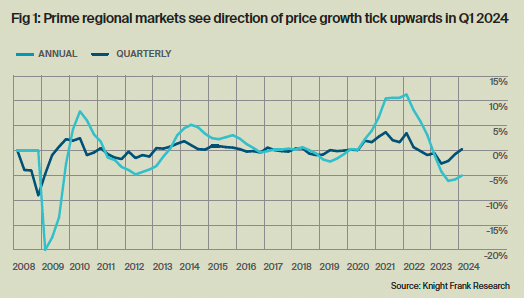Build on the 'grey belt', says the Labour Party
Making sense of the latest trends in property and economics from around the globe
4 minutes to read
A 20-point polling lead six months from the likely date of a general election gives you the breathing space to tackle a few taboos.
Labour leader Keir Starmer last night announced he would allow more development on parts of the green belt, the 16,000 square kilometres of land clustered around 15 cities.
Academics and think tanks have been asking the government to reassess the green belt for as long as we've had a housing crisis, but those calls have so far gone unanswered. Indeed, the green belt has doubled in size since the 1980s and expanded by about 240 sq kms in 2022.
The 'grey belt'
The green belt includes both nature-rich, environmentally valuable land, and, some argue, ugly, desolate spots close to transport links. More than 90% is undeveloped and about 65% is used for agriculture. The land that is developed is generally transport infrastructure - just 0.3% of the green belt has homes on it.
The problem, Labour says, is that planning policy doesn't differentiate between green belt worth protecting and the land that is better suited for homes, so the party will introduce a new 'grey belt' category that encapsulates the latter.
Brownfield land must still be the priority when building on the green belt under Labour's proposed system. When grey belt land is released, plans must target 50% affordable housing.
“The UK desperately needs more homes and modern critical infrastructure to make the country more productive and sustainable, and today’s announcement is one of many steps needed to get us there,” says Melanie Leech, Chief Executive of the British Property Federation.
Rising rents
UK residential rents climbed by a record 9.2% during the year to March, up from 9% in February, the ONS said on Wednesday. London rents surged 11.2%.
Higher mortgage rates are keeping potential buyers locked into the rental market, so there is more competition for limited supply. Meanwhile, landlords are rationalising their portfolios as they are squeezed by higher borrowing costs and expanding regulation.
These figures are comprehensive but they lag other metrics that show the market is cooling. Our current expectation, set out by Ollie Knight in our latest Build to Rent update, is that UK rental inflation will ease 5% in 2024. The lack of supply relative to demand will hold rents above the long-term average, supported by ongoing wage growth. "Any further rationalisation of landlord portfolios in the face of higher mortgage rates, alongside growing regulation, will deepen the existing shortfall, and offset any rise in rental supply coming from the BTR sector," Ollie concludes.
Country homes
Country home price growth has turned positive on a quarterly basis for the first time in almost two years, according to Knight Frank's Prime Country House Index. Values edged up 0.3% during Q1, the first positive reading since June 2022.
On an annual basis values are down 5%, an improvement on the recent low of -6.1% recorded in September 2023. Despite the year-on-year decline, values still sit 11.8% higher than they did at the start of the pandemic in March 2020.
The outlook for the rest of the year will be driven by a number of competing factors, not least the timing and pace of interest rate cuts as well as the timetabling of the General Election, Kate Everett-Allen writes. There is a stand-off between buyers and sellers as higher borrowing costs have tempered budgets resulting in more friction around prices. Needs-based buyers, those moving due to job moves, divorce, schooling etc, have increased their market share as discretionary movers and sellers have opted to wait and observe.

In other news...
Agricultural land values have continued to nudge up in 2024, writes Andrew Shirley. According to the latest results of the Knight Frank Farmland Index, which tracks the average value of bare land in England and Wales, prices rose by 1% in the first quarter of the year to hit another record high of £9,250/acre.
The imbalance between supply and demand that has supported agricultural land values over the past few years will not shift significantly in 2024. Prices will therefore remain in a fairly narrow channel for the rest of the year.
Elsewhere - BoE’s Andrew Bailey insists UK ‘on track’ to quell inflation (FT), Michael Gove vows to reduce ground rents to ‘peppercorn’ levels over time (FT), Citadel doubles its London base in bigger office (Times), consumer confidence at its highest in two years (Times), investors are rapidly moving away from risk assets (Bloomberg), and finally, wealthy Norwegians are moving to Switzerland (Bloomberg).